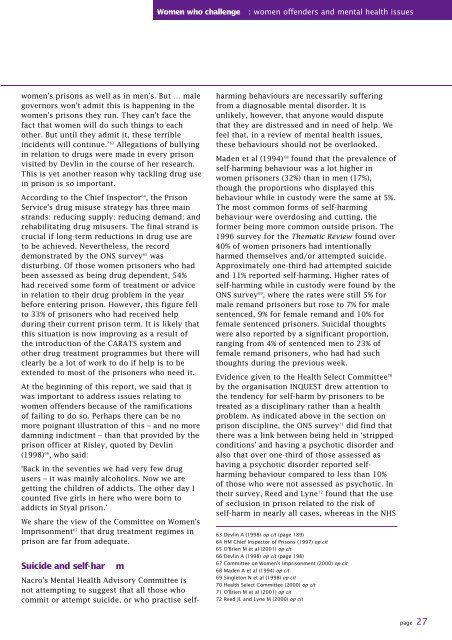Women who challenge - Nacro
Women who challenge - Nacro
Women who challenge - Nacro
- No tags were found...
You also want an ePaper? Increase the reach of your titles
YUMPU automatically turns print PDFs into web optimized ePapers that Google loves.
<strong>Women</strong> <strong>who</strong> <strong>challenge</strong>: women offenders and mental health issueswomen’s prisons as well as in men’s. But … malegovernors won’t admit this is happening in thewomen’s prisons they run. They can’t face thefact that women will do such things to eachother. But until they admit it, these terribleincidents will continue.’ 63 Allegations of bullyingin relation to drugs were made in every prisonvisited by Devlin in the course of her research.This is yet another reason why tackling drug usein prison is so important.According to the Chief Inspector 64 , the PrisonService’s drug misuse strategy has three mainstrands: reducing supply; reducing demand; andrehabilitating drug misusers. The final strand iscrucial if long-term reductions in drug use areto be achieved. Nevertheless, the recorddemonstrated by the ONS survey 65 wasdisturbing. Of those women prisoners <strong>who</strong> hadbeen assessed as being drug dependent, 54%had received some form of treatment or advicein relation to their drug problem in the yearbefore entering prison. However, this figure fellto 33% of prisoners <strong>who</strong> had received helpduring their current prison term. It is likely thatthis situation is now improving as a result ofthe introduction of the CARATS system andother drug treatment programmes but there willclearly be a lot of work to do if help is to beextended to most of the prisoners <strong>who</strong> need it.At the beginning of this report, we said that itwas important to address issues relating towomen offenders because of the ramificationsof failing to do so. Perhaps there can be nomore poignant illustration of this – and no moredamning indictment – than that provided by theprison officer at Risley, quoted by Devlin(1998) 66 , <strong>who</strong> said:‘Back in the seventies we had very few drugusers – it was mainly alcoholics. Now we aregetting the children of addicts. The other day Icounted five girls in here <strong>who</strong> were born toaddicts in Styal prison.’We share the view of the Committee on <strong>Women</strong>’sImprisonment 67 that drug treatment regimes inprison are far from adequate.Suicide and self-harmharming behaviours are necessarily sufferingfrom a diagnosable mental disorder. It isunlikely, however, that anyone would disputethat they are distressed and in need of help. Wefeel that, in a review of mental health issues,these behaviours should not be overlooked.Maden et al (1994) 68 found that the prevalence ofself-harming behaviour was a lot higher inwomen prisoners (32%) than in men (17%),though the proportions <strong>who</strong> displayed thisbehaviour while in custody were the same at 5%.The most common forms of self-harmingbehaviour were overdosing and cutting, theformer being more common outside prison. The1996 survey for the Thematic Review found over40% of women prisoners had intentionallyharmed themselves and/or attempted suicide.Approximately one-third had attempted suicideand 11% reported self-harming. Higher rates ofself-harming while in custody were found by theONS survey 69 , where the rates were still 5% formale remand prisoners but rose to 7% for malesentenced, 9% for female remand and 10% forfemale sentenced prisoners. Suicidal thoughtswere also reported by a significant proportion,ranging from 4% of sentenced men to 23% offemale remand prisoners, <strong>who</strong> had had suchthoughts during the previous week.Evidence given to the Health Select Committee 70by the organisation INQUEST drew attention tothe tendency for self-harm by prisoners to betreated as a disciplinary rather than a healthproblem. As indicated above in the section onprison discipline, the ONS survey 71 did find thatthere was a link between being held in ‘strippedconditions’ and having a psychotic disorder andalso that over one-third of those assessed ashaving a psychotic disorder reported selfharmingbehaviour compared to less than 10%of those <strong>who</strong> were not assessed as psychotic. Intheir survey, Reed and Lyne 72 found that the useof seclusion in prison related to the risk ofself-harm in nearly all cases, whereas in the NHS63 Devlin A (1998) op cit (page 189)64 HM Chief Inspector of Prisons (1997) op cit65 O’Brien M et al (2001) op cit66 Devlin A (1998) op cit (page 198)67 Committee on <strong>Women</strong>’s Imprisonment (2000) op cit68 Maden A et al (1994) op cit69 Singleton N et al (1998) op cit70 Health Select Committee (2000) op cit71 O’Brien M et al (2001) op cit72 Reed JL and Lyne M (2000) op cit<strong>Nacro</strong>’s Mental Health Advisory Committee isnot attempting to suggest that all those <strong>who</strong>commit or attempt suicide, or <strong>who</strong> practise selfpage27
















